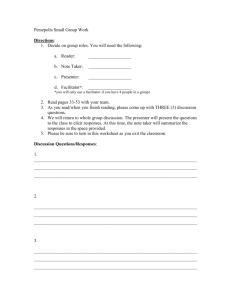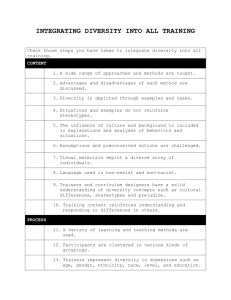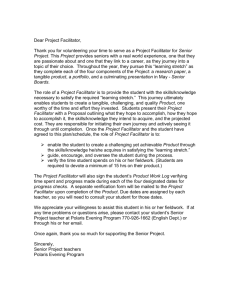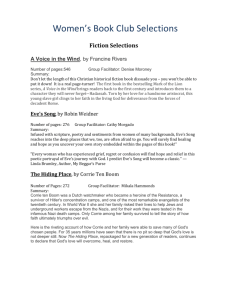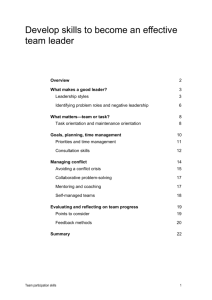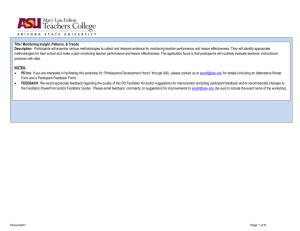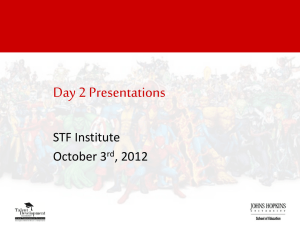Outline of Workshop on Critical Thinking in FOM Teaching
advertisement
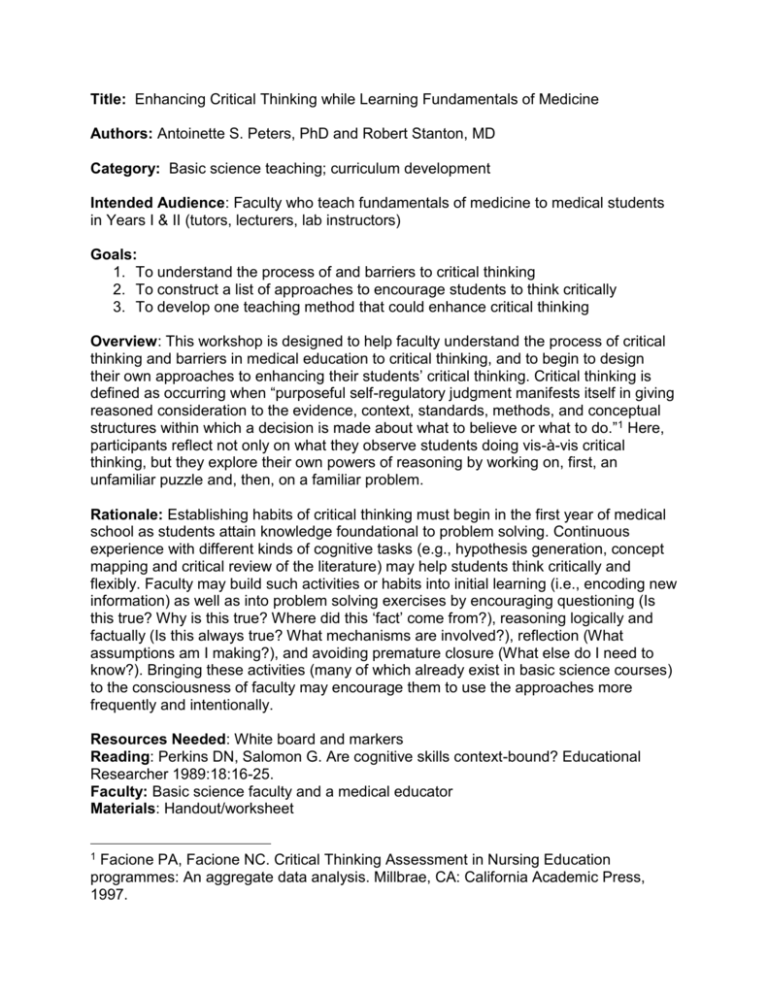
Title: Enhancing Critical Thinking while Learning Fundamentals of Medicine Authors: Antoinette S. Peters, PhD and Robert Stanton, MD Category: Basic science teaching; curriculum development Intended Audience: Faculty who teach fundamentals of medicine to medical students in Years I & II (tutors, lecturers, lab instructors) Goals: 1. To understand the process of and barriers to critical thinking 2. To construct a list of approaches to encourage students to think critically 3. To develop one teaching method that could enhance critical thinking Overview: This workshop is designed to help faculty understand the process of critical thinking and barriers in medical education to critical thinking, and to begin to design their own approaches to enhancing their students’ critical thinking. Critical thinking is defined as occurring when “purposeful self-regulatory judgment manifests itself in giving reasoned consideration to the evidence, context, standards, methods, and conceptual structures within which a decision is made about what to believe or what to do.”1 Here, participants reflect not only on what they observe students doing vis-à-vis critical thinking, but they explore their own powers of reasoning by working on, first, an unfamiliar puzzle and, then, on a familiar problem. Rationale: Establishing habits of critical thinking must begin in the first year of medical school as students attain knowledge foundational to problem solving. Continuous experience with different kinds of cognitive tasks (e.g., hypothesis generation, concept mapping and critical review of the literature) may help students think critically and flexibly. Faculty may build such activities or habits into initial learning (i.e., encoding new information) as well as into problem solving exercises by encouraging questioning (Is this true? Why is this true? Where did this ‘fact’ come from?), reasoning logically and factually (Is this always true? What mechanisms are involved?), reflection (What assumptions am I making?), and avoiding premature closure (What else do I need to know?). Bringing these activities (many of which already exist in basic science courses) to the consciousness of faculty may encourage them to use the approaches more frequently and intentionally. Resources Needed: White board and markers Reading: Perkins DN, Salomon G. Are cognitive skills context-bound? Educational Researcher 1989:18:16-25. Faculty: Basic science faculty and a medical educator Materials: Handout/worksheet 1 Facione PA, Facione NC. Critical Thinking Assessment in Nursing Education programmes: An aggregate data analysis. Millbrae, CA: California Academic Press, 1997. Protocol: (90 minutes) Introduction and statement of goals (5 minutes) As the facilitators and faculty introduce themselves, participants identify the primary instructional format they use (i.e., tutorial, lecture, lab). This information will be used later. One facilitator states the goals. Definition of critical thinking (15 minutes) A facilitated discussion that addresses: 1. What do faculty observe students doing/ not doing vis-à-vis critical thinking? What does it look like in FOM courses? 2. Is there anything the faculty do that promotes this behavior? 3. What inhibits critical thinking in FOM? [see those on attached work sheet] The facilitator presents a brief overview of research on critical thinking, integrating ideas elicited from the participants in this discussion. Puzzles to illustrate principles (15 minutes for each) The educator facilitates discussion of a non-medical/science puzzle, and the basic scientist facilitates discussion of a medically-scientifically oriented problem. Participants work silently and individually so that each person can reflect upon his/her own thought process. After 5 minutes, the facilitator asks a series of questions to foster reflection and insight: 1. Number puzzle. [The facilitator draws the Roman numeral “VII” on the board. S/he instructs the group to move one line to form the quantity of one. The ‘correct’ solution is to move one I horizontally to form the square root of 1]. 1. 2. 3. 4. 5. What knowledge did you use? Did that help or hinder you? What was your thought process? What got in your way? What does this tell you about problem solving and critical thinking? 2. Pathophysiology problem: [A patient presents with a serum sodium of 110. What’s happening pathophysiologically?] 1. 2. 3. 4. 5. What knowledge did you use? Did that help or hinder you? What was your thought process? What got in your way? What does this tell you about problem solving and critical thinking? Brain storming strategies to foster critical thinking in different instructional formats (15 minutes) The facilitator summarizes the elements of critical thinking that the discussions have generated. Participants divide into smaller groups based upon the formats they use to teach. One facilitator presents the Strategies table (attached), suggesting that participants might consider ways to surmount the challenges – assuming they pertain to their primary teaching format – and to foster critical thinking focused on students’ learning about the serum sodium case (above). In groups, participants suggest exercises, questions, didactic approaches, etc. that could be used. Summary (15 minutes) The group share their designs. The facilitator asks: 1. What questions might faculty ask that would model critical thinking? 2. How do you get students to ask themselves these questions as a matter of habit? (Bring the process to the conscious level.) Strategies to Enhance Students’ Critical Thinking Identify the instructional format of primary interest to you. Then, consider whether your students typically encounter particular barriers to critical thinking in this format. What strategies could you use to overcome these barriers and to enhance critical thinking? Instructional Formats Authority2 Challenges to Critical Thinking Premature Knowledge4 Closure3 Medical Culture5 PBL Tutorial Conferences Labs Lectures Generally Critical thinking is defined as occurring when “purposeful self-regulatory judgment manifests itself in giving reasoned consideration to the evidence, context, standards, methods, and conceptual structures within which a decision is made about what to believe or what to do.” Consider how the following contribute to critical thinking: 1. Flexible knowledge 2. Breaking set 3. Mindfulness 4. Reflection 5. Curiosity 6. Tolerance for uncertainty 7. Insight 8. Hypothesis generation 2 The professor is always right. Long tradition of reward for getting the right answer. Selective attention, assumption of red herrings, reliance on pattern recognition, overconfidence, intolerance for uncertainty may all lead to jumping to conclusions. 4 Lack of knowledge upon which to base judgments. Rigid knowledge that does not allow for exceptions. 5 Training toward pattern recognition. Competitive. Reward for being right quickly. 3


